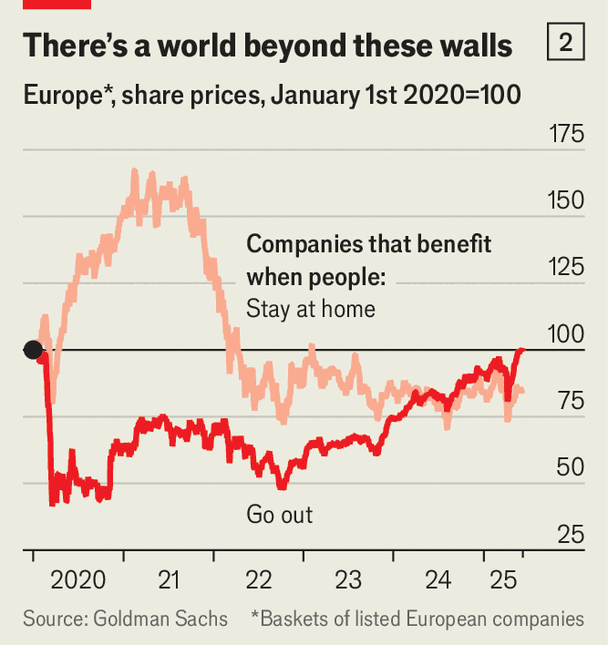The Age of the Loner Consumer
- Sahej Jain
- Jul 26
- 4 min read
The COVID-19 pandemic changed many things — how we work, how we connect, and perhaps most subtly but significantly, how we consume. In the years that followed the global lockdowns, a new consumer archetype quietly emerged: the loner consumer. This individual isn’t necessarily isolated or unhappy, but their spending habits reflect an era that prioritised solitude, self-sufficiency, and digital convenience. From ordering dinner with a tap to working out alone in living rooms and binge-watching TV in silence, millions grew more comfortable being by themselves — and spending accordingly.

Now, in 2025, even as cities are buzzing again and social life has rebounded, the imprint left by those years of isolation is unmistakable. The economy may have tilted back toward social services — restaurants are packed, concerts are selling out, airlines are full — but the underlying psychology of the loner consumer hasn’t disappeared. In many ways, it has evolved, blending seamlessly with a reopened world while still favouring autonomy, flexibility, and independence.
Back in 2020, lockdowns changed consumer behaviour almost overnight. Spending on travel, hospitality, and entertainment plummeted, replaced by a surge in home-centric purchases — fitness equipment, streaming services, desk chairs, and baking kits. People reshaped their lives indoors. The Economist dubbed it the age of the "hermit consumer" — individuals adapting, not escaping. Many found comfort in solitude, productivity in remote work, and control through digital delivery. By 2023, it was clear these habits weren’t just temporary — they were the foundation of a new behavioural pattern that has come to define an entire segment of today’s consumer economy.
Though group experiences have made a strong comeback, many consumers are now more selective, more digital, and more deliberate. The loner consumer is not a recluse, but someone who blends the ease of solitude with the occasional thrill of connection. They might go out on weekends but order groceries online. They’ll attend the occasional yoga retreat but prefer solo workouts during the week. The freedom to choose is paramount — and digital tools have made that freedom possible.
The loner consumer defies demographic boxes. Among young adults in their twenties and thirties — whose coming-of-age years were spent indoors — solo hobbies like gaming, journaling, and content creation have become deeply embedded. Many are delaying marriage or family life and focusing on personalised self-investment, from skincare to online courses. Millennials and Gen Xers, meanwhile, balancing remote work and digital convenience, are drawn to services that offer autonomy: virtual fitness, telehealth, solo travel packages, and flexible working hours. Even older generations, once assumed to be tech-averse, now rely on app-based grocery shopping, digital banking, and streaming platforms. For many retirees, the shift online brought unexpected independence — a lifestyle change that has outlasted the lockdowns.

What this means for business is significant. While social spending is booming again, customer expectations have changed. People expect experiences to be customisable, digital-first, and respectful of their time and privacy. The loner consumer values independence and choice — but not at the cost of quality. A fitness brand might succeed by offering both in-person classes and on-demand videos. A restaurant may thrive with high-end dine-in as well as app-powered takeaway. Retailers are combining AR try-on tools with real-world inventory to meet shoppers where they are — which is often at home, on their couch, making thoughtful purchases between meetings or while relaxing alone.
These consumers also tend to be highly brand-conscious. Having spent years choosing where, how, and with whom they spend time, they’ve become more intentional. They favour companies that offer transparency, respect boundaries, and align with personal values. Personalisation isn’t just a perk — it’s expected. Privacy is non-negotiable. Emotional independence and autonomy are the norm, not the exception.
But this shift goes beyond consumer trends — it reflects a deeper psychological transformation. During the pandemic, solitude was mandated. Over time, it became something else entirely: an opportunity for self-reflection, personal development, and emotional clarity. Many discovered that a quieter lifestyle came with its own benefits — less social comparison, more time to grow, less pressure to conform. Even now, people are less inclined to chase status-driven consumption or peer expectations. The loner consumer isn’t antisocial; they’re selectively social, stepping into social spaces on their own terms.

For policymakers, this evolution offers key takeaways. Digital infrastructure must be strong and accessible — not just for business, but for healthcare, education, and public services. Urban planning should cater not only to crowds but to individuals, offering quiet zones, solo work pods, and seamless transit for one. Labour markets must embrace flexibility, recognising the rise of freelancing, gig work, and remote employment as more than temporary fixes. Mental health support, too, must adapt — loneliness and isolation still pose risks, and public health systems need to address them with nuance and care.
The rise of the loner consumer isn’t just a pandemic side-effect — it’s a cultural shift. Today’s consumers aren’t just “back to normal.” They’re more intentional, more independent, and more focused on curating lives that reflect their inner priorities rather than outer noise. Businesses and governments that acknowledge this shift — and design for it — will be the ones that thrive.
The hermit may have emerged in crisis. But the loner consumer walks by choice — not hidden away, but quietly reshaping the future.






